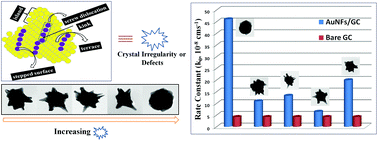Crystal-defect-induced facet-dependent electrocatalytic activity of 3D gold nanoflowers for the selective nanomolar detection of ascorbic acid†
Abstract
Understanding and exploring the decisive factors responsible for superlative catalytic efficiency is necessary to formulate active electrode materials for improved electrocatalysis and high-throughput sensing. This research demonstrates the ability of bud-shaped gold nanoflowers (AuNFs), intermediates in the bud-to-blossom gold nanoflower synthesis, to offer remarkable electrocatalytic efficiency in the oxidation of ascorbic acid (AA) at nanomolar concentrations. Multicomponent sensing in a single potential sweep is measured using differential pulse voltammetry while the kinetic parameters are estimated using electrochemical impedance spectroscopy. The outstanding catalytic activity of bud-structured AuNF [iAuNFp(Bud)/iGCp ≅ 100] compared with other bud-to-blossom intermediate nanostructures is explained by studying their structural transitions, charge distributions, crystalline patterns, and intrinsic irregularities/defects. Detailed microscopic analysis shows that density of crystal defects, such as edges, terraces, steps, ledges, kinks, and dislocation, plays a major role in producing the high catalytic efficiency. An associated ab initio simulation provides necessary support for the projected role of different crystal facets as selective catalytic sites. Density functional theory corroborates the appearance of inter- and intra-molecular hydrogen bonding within AA molecules to control the resultant fingerprint peak potentials at variable concentrations. Bud-structured AuNF facilitates AA detection at nanomolar levels in a multicomponent pathological sample.



 Please wait while we load your content...
Please wait while we load your content...